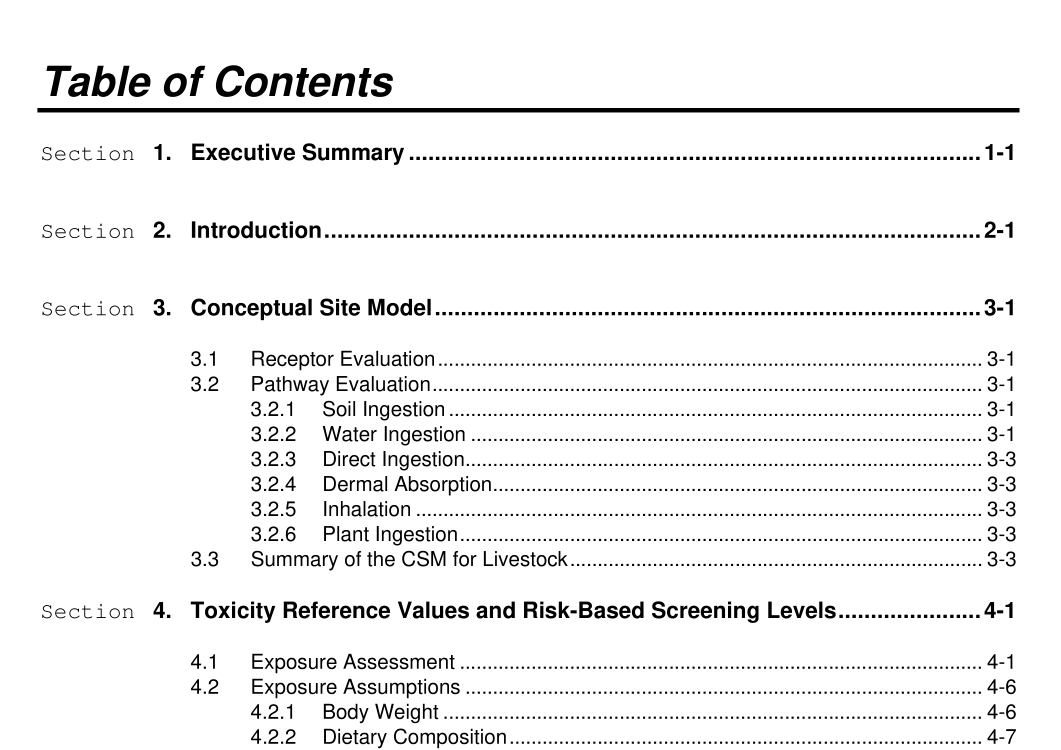API PUBL 4733 pdf download

API PUBL 4733 pdf download.Risk-Based Screening Levels for the Protection of Livestock Exposed to Petroleum Hydrocarbons
3. Conceptual Site Model
A conceptual site model (CSM) identifies complete and potentially complete exposure pathways and receptors to be considered in a risk assessment. If no complete significant pathway(s) exist for exposure of livestock to petroleum hydrocarbons, a screening-level risk evaluation for livestock is not necessary. By definition, if there is little to no significant exposure to a potentially toxic compound, there is little to no likelihood of significant unacceptable risk to the receptor from that compound. A CSM was developed as presented in Figure 1 to assess the potential for exposures to livestock and the need for a risk evaluation. Components of a CSM generally include receptor evaluation and exposure pathway evaluation, which are described below.
3.1 Receptor Evaluation
Livestock that are potentially vulnerable to toxic effects of petroleum hydrocarbons include animals that could ingest significant quantities of soil, water, and/or food in oil-contaminated areas. Access to the contaminated areas is key; cattle, sheep, goats, and horses that forage in pasture areas are more likely to be potential receptors, while species that are raised in more confined and controlled conditions, such as chickens or pigs, would have less chance of exposure to petroleum hydrocarbons. Outside of the United States, other types of livestock animals may also be exposed to petroleum compounds, such as camels, llamas, oxen, etc. It was assumed that exposures to these receptors would be similar to those of typical livestock in the United States based on similarities in body weights and feeding habits.
3.2 Pathway Evaluation
The pathways by which livestock could be exposed to petroleum hydrocarbons are incidental soil ingestion, water ingestion, and direct ingestion, inhalation, dermal absorption, and plant ingestion. Based on available information, the primary exposure pathways considered significant in the exposure model as show in the CSM (Figure 1) included incidental soil ingestion, water ingestion, and direct petroleum product ingestion. Inhalation, dermal absorption, and plant ingestion were considered minor pathways for petroleum hydrocarbons (CCME 2000). The exposure pathways listed above are described in more detail below. 3.2.1 Soil Ingestion Soil can comprise a substantial proportion of the livestock diet. Livestock may consume soil inadvertently during grazing (Zach and Mayoh 1984; CCME 2000) or may intentionally ingest salty-tasting soil (Coppock et al. 1995). According to the CCME (2000), cattle are exposed to petroleum hydrocarbons primarily through consumption of contaminated soils, particularly during grazing. The authors state that the majority of petroleum hydrocarbon exposure in cattle is due to ingestion of surface soils. 3.2.2 Water Ingestion Chronic exposure through drinking water can be a significant exposure pathway for livestock (CCME 2000). The amount of water ingested by cattle varies according to age, physiological status (growth, fattening, pregnancy, lactation), diet composition, breed, size, and, for all animals, temperature (Agriculture and Agri-Food Canada 2001; National Research Council [NRC] 1988).
3.2.3 Direct Ingestion Cattle may directly ingest crude oil and other petroleum compounds from pools of oil formed by leaking pipelines or storage tanks (Edwards and Zinn 1979; Coppock et al. 1995; CCME 2000) due to curiosity (particularly in young calves; Edwards 1985b), or to add salt to their diet (Edwards 1985b, Coppock et al. 1995). Reported cases include steers consuming petroleum distillate, drinking from a slush pit, and drinking petroleum from puddles near a tank battery (Edwards and Zinn 1979). Oil and natural gas industry guidance (API 1997) and many regulatory agencies (e.g., the Railroad Commission of Texas 1993) stress the importance of removing free-oil accumulations on the ground that animals could potentially ingest. 3.2.4 Dermal Absorption Dermal absorption of petroleum hydrocarbons in livestock is considered a minor exposure pathway because of their thick coats (CCME 2000). While methods are available to assess dermal exposure to humans, data necessary to estimate dermal exposure are generally not available for livestock or wildlife (EPA 1993). Additionally, dermal exposure has been shown to be negligible for most terrestrial mammals (EPA 2000).









